Lar's Bar's Build
116 posts
• Page 1 of 4 • 1, 2, 3, 4
Lar's Bar's Build
Ok so I'll start a new thread. Looking to build a set of extended radius arms. So just getting ideas on how to improve this design if it's even possible.
http://www.norcalbroncos.com/forum/show ... =lars+bars
Is 2"od 1/4" wall DOM enough? And what joints to run at the frame? Heim? Johnny joint? Duroflex? What about Ideal length? The arms on my 79 are 15" longer than stock. Is that overkill?
http://www.norcalbroncos.com/forum/show ... =lars+bars
Is 2"od 1/4" wall DOM enough? And what joints to run at the frame? Heim? Johnny joint? Duroflex? What about Ideal length? The arms on my 79 are 15" longer than stock. Is that overkill?
Rob
74 Ranger EFI351w, 4r70w, ARB 5.13 9in, ARB 5.13D44, and a bunch of other goodies. Best of all the family memories.
04 Mustang Cobra, KenneBell 2.2 feeding a lot of boost on E85. Tire shredding machine
New project: 77 Bronco Ranger, body work and more body work.
Very little left of a 72 durango tan explorer sport
74 Ranger EFI351w, 4r70w, ARB 5.13 9in, ARB 5.13D44, and a bunch of other goodies. Best of all the family memories.
04 Mustang Cobra, KenneBell 2.2 feeding a lot of boost on E85. Tire shredding machine
New project: 77 Bronco Ranger, body work and more body work.
Very little left of a 72 durango tan explorer sport
-

ZOSO - Moderator

- Posts: 3908
- Joined: Mon Nov 15, 2010 4:58 pm
- Location: Henderson, Co
Re: Lar's Bar's Build
Curve in bar up front? More tire clearance?
You do not have the required permissions to view the files attached to this post.
Rob
74 Ranger EFI351w, 4r70w, ARB 5.13 9in, ARB 5.13D44, and a bunch of other goodies. Best of all the family memories.
04 Mustang Cobra, KenneBell 2.2 feeding a lot of boost on E85. Tire shredding machine
New project: 77 Bronco Ranger, body work and more body work.
Very little left of a 72 durango tan explorer sport
74 Ranger EFI351w, 4r70w, ARB 5.13 9in, ARB 5.13D44, and a bunch of other goodies. Best of all the family memories.
04 Mustang Cobra, KenneBell 2.2 feeding a lot of boost on E85. Tire shredding machine
New project: 77 Bronco Ranger, body work and more body work.
Very little left of a 72 durango tan explorer sport
-

ZOSO - Moderator

- Posts: 3908
- Joined: Mon Nov 15, 2010 4:58 pm
- Location: Henderson, Co
Re: Lar's Bar's Build
Double tube?
You do not have the required permissions to view the files attached to this post.
Rob
74 Ranger EFI351w, 4r70w, ARB 5.13 9in, ARB 5.13D44, and a bunch of other goodies. Best of all the family memories.
04 Mustang Cobra, KenneBell 2.2 feeding a lot of boost on E85. Tire shredding machine
New project: 77 Bronco Ranger, body work and more body work.
Very little left of a 72 durango tan explorer sport
74 Ranger EFI351w, 4r70w, ARB 5.13 9in, ARB 5.13D44, and a bunch of other goodies. Best of all the family memories.
04 Mustang Cobra, KenneBell 2.2 feeding a lot of boost on E85. Tire shredding machine
New project: 77 Bronco Ranger, body work and more body work.
Very little left of a 72 durango tan explorer sport
-

ZOSO - Moderator

- Posts: 3908
- Joined: Mon Nov 15, 2010 4:58 pm
- Location: Henderson, Co
Re: Lar's Bar's Build
My extended arm circa 2006:


Axle center to joint center was 52", but these were on my Ranger with 125" of wheelbase. Similar to the Lars Bars, but I rotated the lower shock mount 90 degrees because the shock saw more deflection in articulation vs normal jounce and rebound.
I would not put in a bend in the arm for tire clearance unless it is necessary. Bends severly comprimise the compressive strength of the arm.


Axle center to joint center was 52", but these were on my Ranger with 125" of wheelbase. Similar to the Lars Bars, but I rotated the lower shock mount 90 degrees because the shock saw more deflection in articulation vs normal jounce and rebound.
I would not put in a bend in the arm for tire clearance unless it is necessary. Bends severly comprimise the compressive strength of the arm.
Cummins R2.8 diesel, ZF5, AtlasII, HP44/BB9, ARBs, coiled / linked suspension, 37" KO2s, full cage, bumpers, etc.
Build Thread: http://www.coloradoclassicbroncos.com/viewtopic.php?f=3&t=5420
Average 23.5 mpg, Best tank: 25.1 mpg
Build Thread: http://www.coloradoclassicbroncos.com/viewtopic.php?f=3&t=5420
Average 23.5 mpg, Best tank: 25.1 mpg
-
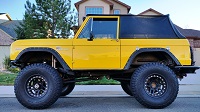
Digger - Official CCB Member

- Posts: 1276
- Joined: Fri Jun 21, 2013 7:53 pm
Re: Lar's Bar's Build
What about the frame mounts? Would that be a good fit for a metalcloak duroflex joint? I want to build something strong yet not over build and add tons of weight.
A Primer on suspension joints:
There are 2 main styles of suspension joints currently on the market, bushings and cross axis ball joints. Others are hybrids of the main two.
RUBBER BUSHINGS:
This is the standard which all OEMs use. There are two main types, double bonded and compression.
1) Double bonded is the most common. They consist of an outer shell and an inner metal with rubber bonding the two together. In this case, the rubber is attached to the metal.
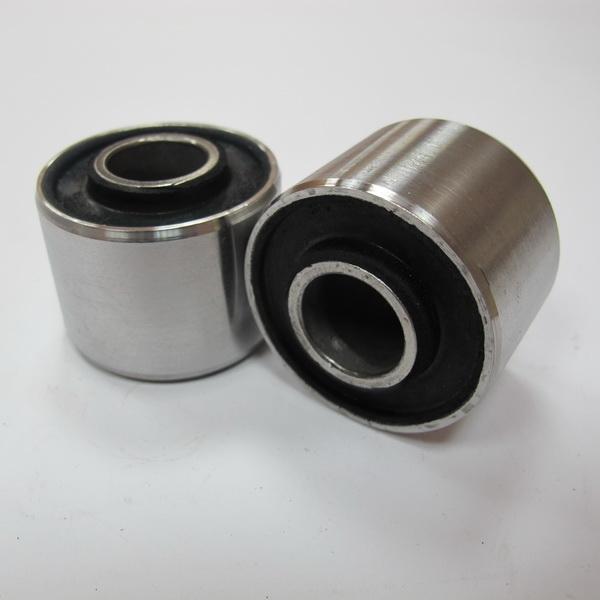
2) Compression bushings. These are a good choice for high travel suspensions and are common on Jeep JKs, TJs, Grand Cherokees, Cherokees, etc. They are non-bonded, so when over-traveled, they don't tear, they just slip. Typical construction involves molding the rubber seperate and then compressing it down and shoving it into a metal can. They utilize features to keep the bushing from walking out axially
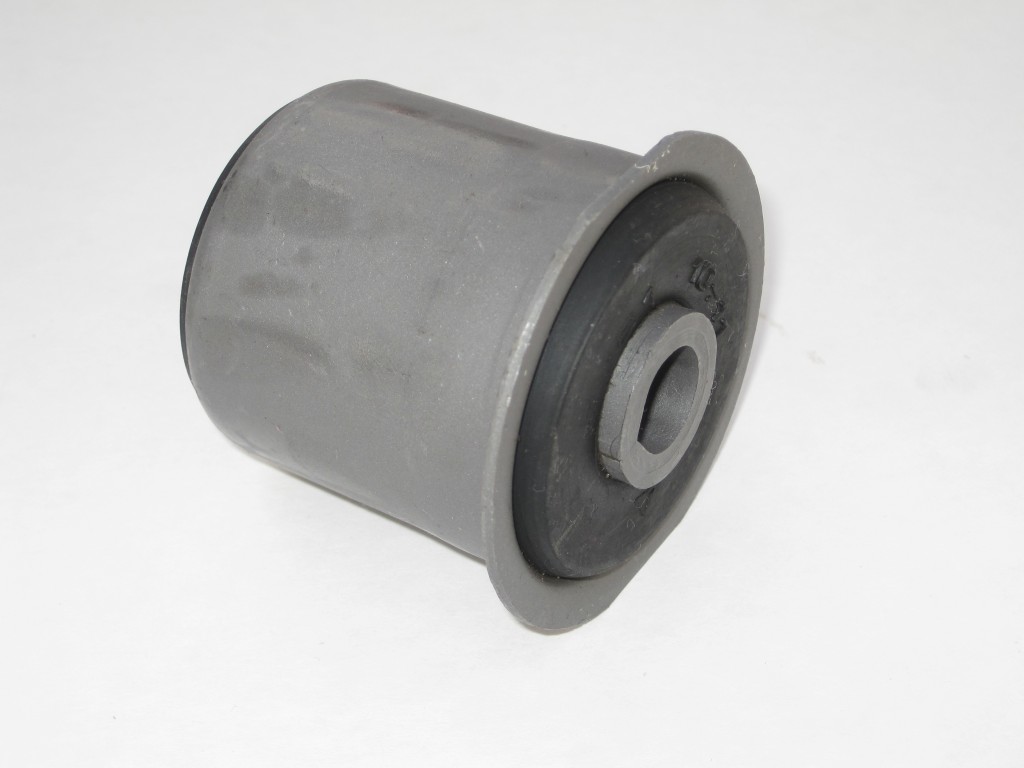
Rubber bushings are compliant in all directions, they have a spring rate in the Radial, Axial, Torsional, and Conical directions. Despite their benefits, one reason they are not common in the aftermarket is that there are few companies stateside that produce bushings and most do not cater to small run customers. China is the alternative, but quality is much lower.
CROSS AXIS BALL JOINTS
CABJs are built just like conventional ball joints with a through bolted connection. They have zero compliance in the X, Y, and Z directions, but can freely rotate in Yaw, Pitch, and Roll. (i.e. free rotation, no translation) They provide freedom of motion, but cannont absorb shock and vibration. Examples in the aftermarket would be Rubicon Express and Ballistic joints

URETHANE BUSHINGS
These fall under the bushing category. Urethane is common in the aftermarket because it is cheap and easy to manufacture. The difference is rubber behaves like a spring, it compresses and stretchs. Urethane behaves more like a liquid, when it is forced to be displaced, it doesn't compress, it moves somewhere else. This can be a very important design consideration. Additionally urethane can split easy once a crack has started.
JOHNNY JOINTS
I consider this a hybrid. They are constructed like a CABJ, but use a urethane race, so while they mostly function like a ball joint, they have some compliance like a bushing. (but not much)
METALCLOAK DUROFLEX JOINTS
I'm showing my bias here, but I saw these at Jeep Safari the same year my company unvielled our xAxis joint, and I thought these were one of the most inovative things at the show. (The MetalCloak guys had similar thoughts about my joints)
While functionally a single-bonded compression bushing, they are shaped to allow greater roational freedom like a ball joint, but still have radial, axial, and torsional compliance like Jeep Clevite bushings. This makes them a good choice for a joint that needs high mis-alignment, but can't comprimise the benefits of a rubber bushing.
RADIUS ARM MOUNTS
It's hard to say how to construct these because there are some many factors to consider. Basically the crossbolted joint like a Johnny Joint or convention bushing would be better than the Ford radius arm bushings. The Ford design is robust for normal use, but is lacking for high travel suspensions. Brackets can be anywhere from 1/8" to 1/4" thick. For most purposes 1/8" is adaquate with 3/16" being heavy duty and 1/4" being bomb-proof. The closer the radius arm mounts are to each other on the frame side, the less bind will be induced into the axle resulting in greater flex.
RADIUS ARM CONSTRUCTION
I prefer extended radius arms to wristed ones. They are more robust and do not suffer from geometry drawbacks, but are harder to package under the truck.
To build extended arms, I like to cut off the axle end of the factory radius arms leaving ~8" of the I-beam section to attach the tube. For the extension tube, round is easy to work with but square or rectangle cross section has better bending strength for bent or relieved arms. The problem is, it's harder to bend it and bending dies are not as common. I chose 2" x .250" DOM round tube. This is heavy tube and generally overkill, however given the original length of my arms (52") I needed to be concerned about bending strength in the middle of the arm if I were to set the truck down on a rock. As it ended up, I did turtle my truck on a very large rock and there was considerable bowing of the radius arm. Luckly for me, they were still within the elastic region of their stress curve and bounced back into shape once the truck was off the rock.
Cummins R2.8 diesel, ZF5, AtlasII, HP44/BB9, ARBs, coiled / linked suspension, 37" KO2s, full cage, bumpers, etc.
Build Thread: http://www.coloradoclassicbroncos.com/viewtopic.php?f=3&t=5420
Average 23.5 mpg, Best tank: 25.1 mpg
Build Thread: http://www.coloradoclassicbroncos.com/viewtopic.php?f=3&t=5420
Average 23.5 mpg, Best tank: 25.1 mpg
-

Digger - Official CCB Member

- Posts: 1276
- Joined: Fri Jun 21, 2013 7:53 pm
Re: Lar's Bar's Build
If you're not extending too much, 2"x.25"DOM is adequate. I would think you'd still be fine even with a slight bend in them. I didn't bend mine, but instead built my own mounts off the inside of the frame, so I gained some turning radius while keeping the links straight. I also used this joint at the frame which allows some adjustment:
http://www.ballisticfabrication.com/For ... _2012.html
Folks could use a rubber bushing instead of the Ballistic Joint if they are more concerned with road manners as opposed to flex. This would allow you to build them all the same and guys could source their own joints.
http://www.ballisticfabrication.com/Bal ... _1646.html
Mine is an upper and lower link (Y-link?), allowing caster adjustment, but you could still use the c-bushings for that with your setup. I would think a twin tube complicates the design. Stronger, but possibly unnecessarily so.
Also, it might be a headache, but instead of trimming out the web in the factory arm, wouldn't it be better to slot the DOM? That could be more of a hassle, but it'd be stronger. Cut the factory arm off where the web is 2 1/8" tall, sandwich it between the slot in the DOM and weld it together.
With a nice flexible joint at the frame, you wouldn't have to extend the arms much to gain tons of flex.
http://www.ballisticfabrication.com/For ... _2012.html
Folks could use a rubber bushing instead of the Ballistic Joint if they are more concerned with road manners as opposed to flex. This would allow you to build them all the same and guys could source their own joints.
http://www.ballisticfabrication.com/Bal ... _1646.html
Mine is an upper and lower link (Y-link?), allowing caster adjustment, but you could still use the c-bushings for that with your setup. I would think a twin tube complicates the design. Stronger, but possibly unnecessarily so.
Also, it might be a headache, but instead of trimming out the web in the factory arm, wouldn't it be better to slot the DOM? That could be more of a hassle, but it'd be stronger. Cut the factory arm off where the web is 2 1/8" tall, sandwich it between the slot in the DOM and weld it together.
With a nice flexible joint at the frame, you wouldn't have to extend the arms much to gain tons of flex.
1973 Bronco, 351 SEFI, Locked, discs, 35's ZF-5spd and Atlas 4spd. 235:1 Crawl Ratio. It may be ugly, but it's slow.
http://www.ucora.org
http://www.ucora.org
-
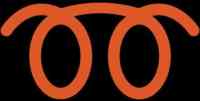
Jesus_man - Official CCB Member

- Posts: 5987
- Joined: Thu Nov 11, 2010 9:36 am
- Location: California
Re: Lar's Bar's Build
Here's what I did on my 79. They are HEAVY!!!! Always wanted to cut off the stud on the frame side and put a JJ on there. They atarted with an extension of 15" over stock. Then fully boxed with 3x3x1/4" angle iron cut to fit. Fully welded. They work great the way they are but always figured a Johnny Joint or heim on the end would be the cats meow.
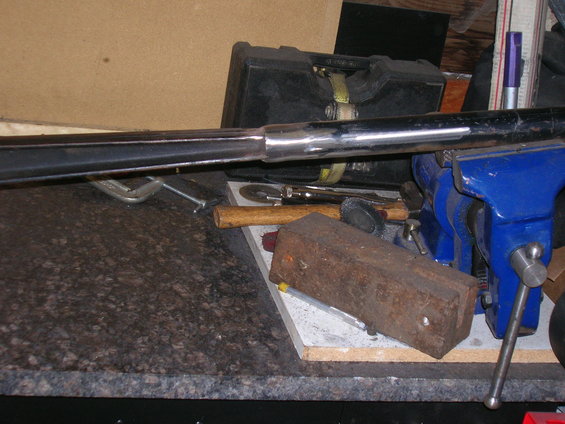
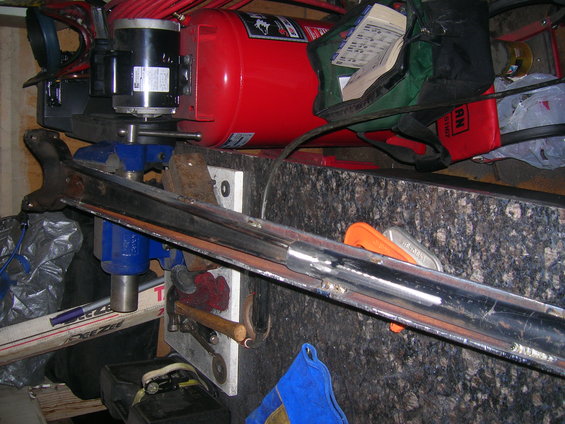
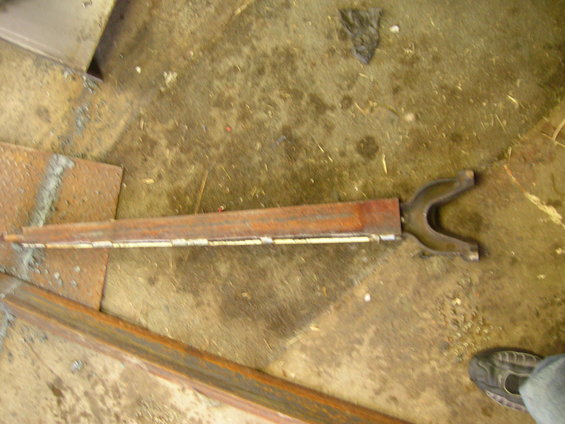
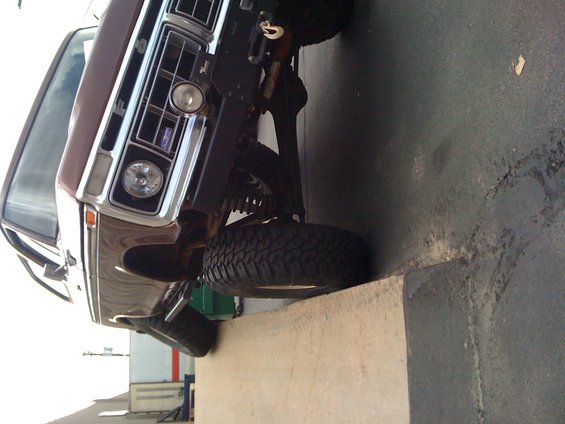
Im just wanting to try something a little different and really like the duff arms just im too cheap to spend 700+ for a set.
Im betting we can get a club discount on the xAxis joints and buy some bulk 2" 250 dom. Im ready to build a set after the first of the year.




Im just wanting to try something a little different and really like the duff arms just im too cheap to spend 700+ for a set.
Im betting we can get a club discount on the xAxis joints and buy some bulk 2" 250 dom. Im ready to build a set after the first of the year.
Rob
74 Ranger EFI351w, 4r70w, ARB 5.13 9in, ARB 5.13D44, and a bunch of other goodies. Best of all the family memories.
04 Mustang Cobra, KenneBell 2.2 feeding a lot of boost on E85. Tire shredding machine
New project: 77 Bronco Ranger, body work and more body work.
Very little left of a 72 durango tan explorer sport
74 Ranger EFI351w, 4r70w, ARB 5.13 9in, ARB 5.13D44, and a bunch of other goodies. Best of all the family memories.
04 Mustang Cobra, KenneBell 2.2 feeding a lot of boost on E85. Tire shredding machine
New project: 77 Bronco Ranger, body work and more body work.
Very little left of a 72 durango tan explorer sport
-

ZOSO - Moderator

- Posts: 3908
- Joined: Mon Nov 15, 2010 4:58 pm
- Location: Henderson, Co
Re: Lar's Bar's Build
How about square tubing? I believe WH has there arms built like this.
You do not have the required permissions to view the files attached to this post.
Rob
74 Ranger EFI351w, 4r70w, ARB 5.13 9in, ARB 5.13D44, and a bunch of other goodies. Best of all the family memories.
04 Mustang Cobra, KenneBell 2.2 feeding a lot of boost on E85. Tire shredding machine
New project: 77 Bronco Ranger, body work and more body work.
Very little left of a 72 durango tan explorer sport
74 Ranger EFI351w, 4r70w, ARB 5.13 9in, ARB 5.13D44, and a bunch of other goodies. Best of all the family memories.
04 Mustang Cobra, KenneBell 2.2 feeding a lot of boost on E85. Tire shredding machine
New project: 77 Bronco Ranger, body work and more body work.
Very little left of a 72 durango tan explorer sport
-

ZOSO - Moderator

- Posts: 3908
- Joined: Mon Nov 15, 2010 4:58 pm
- Location: Henderson, Co
Re: Lar's Bar's Build
ZOSO wrote:How about square tubing? I believe WH has there arms built like this.
Square tubing of comparable size will be stronger in bending. (In the planes of the flat sides. so horizontal and vertical planes in this case) This means the radius arm you show is less likely to collapse than one made of equal sized round tube.
This is only a concern if you are building for light weight. On my arms, I wanted ease of manufacture at the time, so I used slightly heavier 2" x .250" DOM round tube to get the job done.
Cummins R2.8 diesel, ZF5, AtlasII, HP44/BB9, ARBs, coiled / linked suspension, 37" KO2s, full cage, bumpers, etc.
Build Thread: http://www.coloradoclassicbroncos.com/viewtopic.php?f=3&t=5420
Average 23.5 mpg, Best tank: 25.1 mpg
Build Thread: http://www.coloradoclassicbroncos.com/viewtopic.php?f=3&t=5420
Average 23.5 mpg, Best tank: 25.1 mpg
-

Digger - Official CCB Member

- Posts: 1276
- Joined: Fri Jun 21, 2013 7:53 pm
Re: Lar's Bar's Build
I am paying very close attention to this thread, trying to learn all I can. I will be building 2-3 sets over the next few years including the first set to install on Wilma as soon as we have this build day.
[color=#BFFF40]Greg
If you are the smartest person in the room -
You are in the wrong room
If you are the smartest person in the room -
You are in the wrong room
-

hockeydad4-22 - Official CCB Member

- Posts: 2378
- Joined: Tue Nov 02, 2010 12:11 pm
- Location: Highlands Ranch Colorado
Re: Lar's Bar's Build
hockeydad4-22 wrote:I am paying very close attention to this thread, trying to learn all I can. I will be building 2-3 sets over the next few years including the first set to install on Wilma as soon as we have this build day.
Im fully wanting to do it this winter. I wanna say we shoot for february-ish to hold a tech day. Justin how does that sound? If we just do the 2" .250 tube in straight pieces it should be fairly simple to build a few set's in a weekend.
Digger do you have a good steel supplier? How about a way of getting us a group price on xAxis joints? Say this one? http://www.spcalignment.com/component/s ... &pid=15740
Polyperformance has 1026 DOM (2) 48" pieces for $108.
Rob
74 Ranger EFI351w, 4r70w, ARB 5.13 9in, ARB 5.13D44, and a bunch of other goodies. Best of all the family memories.
04 Mustang Cobra, KenneBell 2.2 feeding a lot of boost on E85. Tire shredding machine
New project: 77 Bronco Ranger, body work and more body work.
Very little left of a 72 durango tan explorer sport
74 Ranger EFI351w, 4r70w, ARB 5.13 9in, ARB 5.13D44, and a bunch of other goodies. Best of all the family memories.
04 Mustang Cobra, KenneBell 2.2 feeding a lot of boost on E85. Tire shredding machine
New project: 77 Bronco Ranger, body work and more body work.
Very little left of a 72 durango tan explorer sport
-

ZOSO - Moderator

- Posts: 3908
- Joined: Mon Nov 15, 2010 4:58 pm
- Location: Henderson, Co
Re: Lar's Bar's Build
We can find dom locally no problem. Im open for dates in both Januaryand February. With a jig we can do multiple sets no problem, and bent arms won't add much time.
-
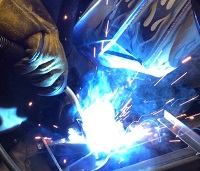
Justin - Official CCB Member

- Posts: 6198
- Images: 0
- Joined: Sat Oct 09, 2010 11:04 pm
- Location: Lakewood
Re: Lar's Bar's Build
I can talk to vendors about s deal on brackets as well.
-

Justin - Official CCB Member

- Posts: 6198
- Images: 0
- Joined: Sat Oct 09, 2010 11:04 pm
- Location: Lakewood
Re: Lar's Bar's Build
I'll check with Hinton for the DOM, I get a fair deal if they have it in stock.
Best to Date MPG: 26.6
-
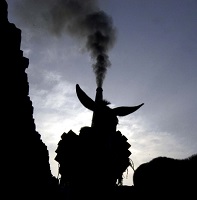
Kinder - Official CCB Member

- Posts: 4371
- Images: 0
- Joined: Wed Sep 29, 2010 9:03 pm
- Location: Parker, CO
Re: Lar's Bar's Build
ZOSO wrote:hockeydad4-22 wrote:I am paying very close attention to this thread, trying to learn all I can. I will be building 2-3 sets over the next few years including the first set to install on Wilma as soon as we have this build day.
Im fully wanting to do it this winter. I wanna say we shoot for february-ish to hold a tech day. Justin how does that sound? If we just do the 2" .250 tube in straight pieces it should be fairly simple to build a few set's in a weekend.
Digger do you have a good steel supplier? How about a way of getting us a group price on xAxis joints? Say this one? http://www.spcalignment.com/component/s ... &pid=15740
Polyperformance has 1026 DOM (2) 48" pieces for $108.
I look into pricing on that xAxis joint.
As far as tube, I usually go to Tube Services, but we may want to look at EJM metals as well. TS doesn't like dealing with onsie-twosie orders, but EMJ will buy bulk from TS and sell 1s and 2s for less money.
Cummins R2.8 diesel, ZF5, AtlasII, HP44/BB9, ARBs, coiled / linked suspension, 37" KO2s, full cage, bumpers, etc.
Build Thread: http://www.coloradoclassicbroncos.com/viewtopic.php?f=3&t=5420
Average 23.5 mpg, Best tank: 25.1 mpg
Build Thread: http://www.coloradoclassicbroncos.com/viewtopic.php?f=3&t=5420
Average 23.5 mpg, Best tank: 25.1 mpg
-

Digger - Official CCB Member

- Posts: 1276
- Joined: Fri Jun 21, 2013 7:53 pm
Re: Lar's Bar's Build
Justin wrote:We can find dom locally no problem. Im open for dates in both Januaryand February. With a jig we can do multiple sets no problem, and bent arms won't add much time.
Bending 2"x0.25" DOM may be a challenge unless someone has a JD2 Model32 or similar. Tube that heavy takes some serious bending force.
Cummins R2.8 diesel, ZF5, AtlasII, HP44/BB9, ARBs, coiled / linked suspension, 37" KO2s, full cage, bumpers, etc.
Build Thread: http://www.coloradoclassicbroncos.com/viewtopic.php?f=3&t=5420
Average 23.5 mpg, Best tank: 25.1 mpg
Build Thread: http://www.coloradoclassicbroncos.com/viewtopic.php?f=3&t=5420
Average 23.5 mpg, Best tank: 25.1 mpg
-

Digger - Official CCB Member

- Posts: 1276
- Joined: Fri Jun 21, 2013 7:53 pm
Lar's Bar's Build
I've got a JD2 w/ 2" dies, it'll bend it. We can bolt it to Justin's floor as long as he doesn't mind 4 lags in his concrete.
Edit: I've got a call into Hinton for tube pricing.
Edit: I've got a call into Hinton for tube pricing.
Best to Date MPG: 26.6
-

Kinder - Official CCB Member

- Posts: 4371
- Images: 0
- Joined: Wed Sep 29, 2010 9:03 pm
- Location: Parker, CO
Re: Lar's Bar's Build
Kirk, I don't mind putting lugs in my garage floor, but I'm not sure that thing is rated for .25 wall. It's a model 3, right?
-

Justin - Official CCB Member

- Posts: 6198
- Images: 0
- Joined: Sat Oct 09, 2010 11:04 pm
- Location: Lakewood
Re: Lar's Bar's Build
Hmmm I'll need to check. I know the guy that owned it before me bent .25 wall but it may not be rated for it.
Best to Date MPG: 26.6
-

Kinder - Official CCB Member

- Posts: 4371
- Images: 0
- Joined: Wed Sep 29, 2010 9:03 pm
- Location: Parker, CO
Re: Lar's Bar's Build
kinder wrote:Hmmm I'll need to check. I know the guy that owned it before me bent .25 wall but it may not be rated for it.
The reason I mention it was I bent 1.5" x .25" DOM with my JD2 model 3. I did one bend no problem, the second bend broke the die. The Model 3 is technically not rated for .25" wall, especailly DOM which has higher cold-worked strength.
Cummins R2.8 diesel, ZF5, AtlasII, HP44/BB9, ARBs, coiled / linked suspension, 37" KO2s, full cage, bumpers, etc.
Build Thread: http://www.coloradoclassicbroncos.com/viewtopic.php?f=3&t=5420
Average 23.5 mpg, Best tank: 25.1 mpg
Build Thread: http://www.coloradoclassicbroncos.com/viewtopic.php?f=3&t=5420
Average 23.5 mpg, Best tank: 25.1 mpg
-

Digger - Official CCB Member

- Posts: 1276
- Joined: Fri Jun 21, 2013 7:53 pm
Re: Lar's Bar's Build
I wouldn't try to bend .25" wall in that bender. I've seen a quite a few break trying it. For the 6°-10° bend in a radius arm the harbor freight pipe bender of mine that Justin has is perfectly fine. I've bent 1.5" od .25" wall DOM, 1.75" od .25" wall DOM and 2" od .25" wall DOM more than 20° without visible deformation of the bend radius. Plus it was $80 so if something happens to the bender it's of no concern at all.
There is a fine line between "hobby" and "mental illness"
-
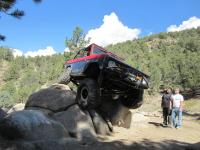
crawlercreations - Official CCB Member

- Posts: 1101
- Joined: Sat Nov 06, 2010 8:36 pm
- Location: Arvada
Re: Lar's Bar's Build
Well if lags in the floor are required, I will supply them and the hammer drill to install them
[color=#BFFF40]Greg
If you are the smartest person in the room -
You are in the wrong room
If you are the smartest person in the room -
You are in the wrong room
-

hockeydad4-22 - Official CCB Member

- Posts: 2378
- Joined: Tue Nov 02, 2010 12:11 pm
- Location: Highlands Ranch Colorado
Re: Lar's Bar's Build
I've got both here. Thanks, though!
-

Justin - Official CCB Member

- Posts: 6198
- Images: 0
- Joined: Sat Oct 09, 2010 11:04 pm
- Location: Lakewood
Re: Lar's Bar's Build
If there is going to be a bend in the I'd prefer it to be at the front like the square tube ones I posted for tire clearance. But ones that dont have a bend are stronger. Now granted for me Im not wheelin my bronco really hard but dont want a radius arm to fold up on me.
Rob
74 Ranger EFI351w, 4r70w, ARB 5.13 9in, ARB 5.13D44, and a bunch of other goodies. Best of all the family memories.
04 Mustang Cobra, KenneBell 2.2 feeding a lot of boost on E85. Tire shredding machine
New project: 77 Bronco Ranger, body work and more body work.
Very little left of a 72 durango tan explorer sport
74 Ranger EFI351w, 4r70w, ARB 5.13 9in, ARB 5.13D44, and a bunch of other goodies. Best of all the family memories.
04 Mustang Cobra, KenneBell 2.2 feeding a lot of boost on E85. Tire shredding machine
New project: 77 Bronco Ranger, body work and more body work.
Very little left of a 72 durango tan explorer sport
-

ZOSO - Moderator

- Posts: 3908
- Joined: Mon Nov 15, 2010 4:58 pm
- Location: Henderson, Co
Re: Lar's Bar's Build
Okay guys, I need an idea of how many xAxis joints we would be purchasing as a group to determine an exact discount. Please reply with how many you would be interested in. I will reply to you via IM when I have pricing.
Right now we are looking at this model: http://www.spcalignment.com/component/spc/?task=part_description&pid=15740
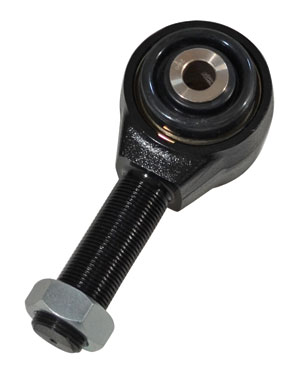
SPECS:
Stud: 1"-14 Right Hand thread
Through Bolt: 9/16" (14mm)
Joint Width: 2.625"
Joint Articulation: 45 degrees
Receiver Material: Heat treated forged alloy steel
Finish: OE grade E-coat
Joint features fully sealed EPDM rubber boots, moly-impregnated Nylon 6/6 race, electroless nickel coated inner ball and is lubed with heavy duty moly fortifed chassis grease. The boots are replaceable if damaged and the joint cartridge can be replaced when worn out by removing retaining ring and pressing the joint out.
Honestly, this joint should not need replacement for many years/miles. It is designed like an OE joint which is intended to be service free for 100K-150K miles.
Pricing:
Currently equilvant units like Johnny Joints to Ballistic joints are retailing for $45-$60 each. We should be able to come in at the bottom of that range for price, maybe lower depending on quanity. I couldn't get an exact number out of sales without a quanity. The big thing to remember is that you're buying a better quality joint with greater articulation for a price on par or lower than other options out there.
If you have any questions, feel free to IM me or reply here
CURRENT COUNT:
Total: 12-14x
Justin 2x (may need RH/LH)
ZOSO 2x
JGZ 2-4x
Kinder 2x (need to confirm size)
Landshark 2x (need to confirm size)
Eck 2x (tentative)
Right now we are looking at this model: http://www.spcalignment.com/component/spc/?task=part_description&pid=15740

SPECS:
Stud: 1"-14 Right Hand thread
Through Bolt: 9/16" (14mm)
Joint Width: 2.625"
Joint Articulation: 45 degrees
Receiver Material: Heat treated forged alloy steel
Finish: OE grade E-coat
Joint features fully sealed EPDM rubber boots, moly-impregnated Nylon 6/6 race, electroless nickel coated inner ball and is lubed with heavy duty moly fortifed chassis grease. The boots are replaceable if damaged and the joint cartridge can be replaced when worn out by removing retaining ring and pressing the joint out.
Honestly, this joint should not need replacement for many years/miles. It is designed like an OE joint which is intended to be service free for 100K-150K miles.
Pricing:
Currently equilvant units like Johnny Joints to Ballistic joints are retailing for $45-$60 each. We should be able to come in at the bottom of that range for price, maybe lower depending on quanity. I couldn't get an exact number out of sales without a quanity. The big thing to remember is that you're buying a better quality joint with greater articulation for a price on par or lower than other options out there.
If you have any questions, feel free to IM me or reply here
CURRENT COUNT:
Total: 12-14x
Justin 2x (may need RH/LH)
ZOSO 2x
JGZ 2-4x
Kinder 2x (need to confirm size)
Landshark 2x (need to confirm size)
Eck 2x (tentative)
Last edited by Digger on Wed Dec 17, 2014 11:19 am, edited 2 times in total.
Cummins R2.8 diesel, ZF5, AtlasII, HP44/BB9, ARBs, coiled / linked suspension, 37" KO2s, full cage, bumpers, etc.
Build Thread: http://www.coloradoclassicbroncos.com/viewtopic.php?f=3&t=5420
Average 23.5 mpg, Best tank: 25.1 mpg
Build Thread: http://www.coloradoclassicbroncos.com/viewtopic.php?f=3&t=5420
Average 23.5 mpg, Best tank: 25.1 mpg
-

Digger - Official CCB Member

- Posts: 1276
- Joined: Fri Jun 21, 2013 7:53 pm
Re: Lar's Bar's Build
I'll take two. I'll need to drop my radius arms to confirm, but I may need one LH and one RH. Frankly, I may be interested whether we do a group buy or not. Those look sweet.
-

Justin - Official CCB Member

- Posts: 6198
- Images: 0
- Joined: Sat Oct 09, 2010 11:04 pm
- Location: Lakewood
Re: Lar's Bar's Build
I'd need a pair.
Rob
74 Ranger EFI351w, 4r70w, ARB 5.13 9in, ARB 5.13D44, and a bunch of other goodies. Best of all the family memories.
04 Mustang Cobra, KenneBell 2.2 feeding a lot of boost on E85. Tire shredding machine
New project: 77 Bronco Ranger, body work and more body work.
Very little left of a 72 durango tan explorer sport
74 Ranger EFI351w, 4r70w, ARB 5.13 9in, ARB 5.13D44, and a bunch of other goodies. Best of all the family memories.
04 Mustang Cobra, KenneBell 2.2 feeding a lot of boost on E85. Tire shredding machine
New project: 77 Bronco Ranger, body work and more body work.
Very little left of a 72 durango tan explorer sport
-

ZOSO - Moderator

- Posts: 3908
- Joined: Mon Nov 15, 2010 4:58 pm
- Location: Henderson, Co
Re: Lar's Bar's Build
Phil, Mike, Jeff what about you guy's?
Rob
74 Ranger EFI351w, 4r70w, ARB 5.13 9in, ARB 5.13D44, and a bunch of other goodies. Best of all the family memories.
04 Mustang Cobra, KenneBell 2.2 feeding a lot of boost on E85. Tire shredding machine
New project: 77 Bronco Ranger, body work and more body work.
Very little left of a 72 durango tan explorer sport
74 Ranger EFI351w, 4r70w, ARB 5.13 9in, ARB 5.13D44, and a bunch of other goodies. Best of all the family memories.
04 Mustang Cobra, KenneBell 2.2 feeding a lot of boost on E85. Tire shredding machine
New project: 77 Bronco Ranger, body work and more body work.
Very little left of a 72 durango tan explorer sport
-

ZOSO - Moderator

- Posts: 3908
- Joined: Mon Nov 15, 2010 4:58 pm
- Location: Henderson, Co
Re: Lar's Bar's Build
Jeremy, I know you have a few extra set's you want to build long arms out of.
Rob
74 Ranger EFI351w, 4r70w, ARB 5.13 9in, ARB 5.13D44, and a bunch of other goodies. Best of all the family memories.
04 Mustang Cobra, KenneBell 2.2 feeding a lot of boost on E85. Tire shredding machine
New project: 77 Bronco Ranger, body work and more body work.
Very little left of a 72 durango tan explorer sport
74 Ranger EFI351w, 4r70w, ARB 5.13 9in, ARB 5.13D44, and a bunch of other goodies. Best of all the family memories.
04 Mustang Cobra, KenneBell 2.2 feeding a lot of boost on E85. Tire shredding machine
New project: 77 Bronco Ranger, body work and more body work.
Very little left of a 72 durango tan explorer sport
-

ZOSO - Moderator

- Posts: 3908
- Joined: Mon Nov 15, 2010 4:58 pm
- Location: Henderson, Co
116 posts
• Page 1 of 4 • 1, 2, 3, 4
Return to General 4x4 Technical
Who is online
Users browsing this forum: No registered users and 1 guest
